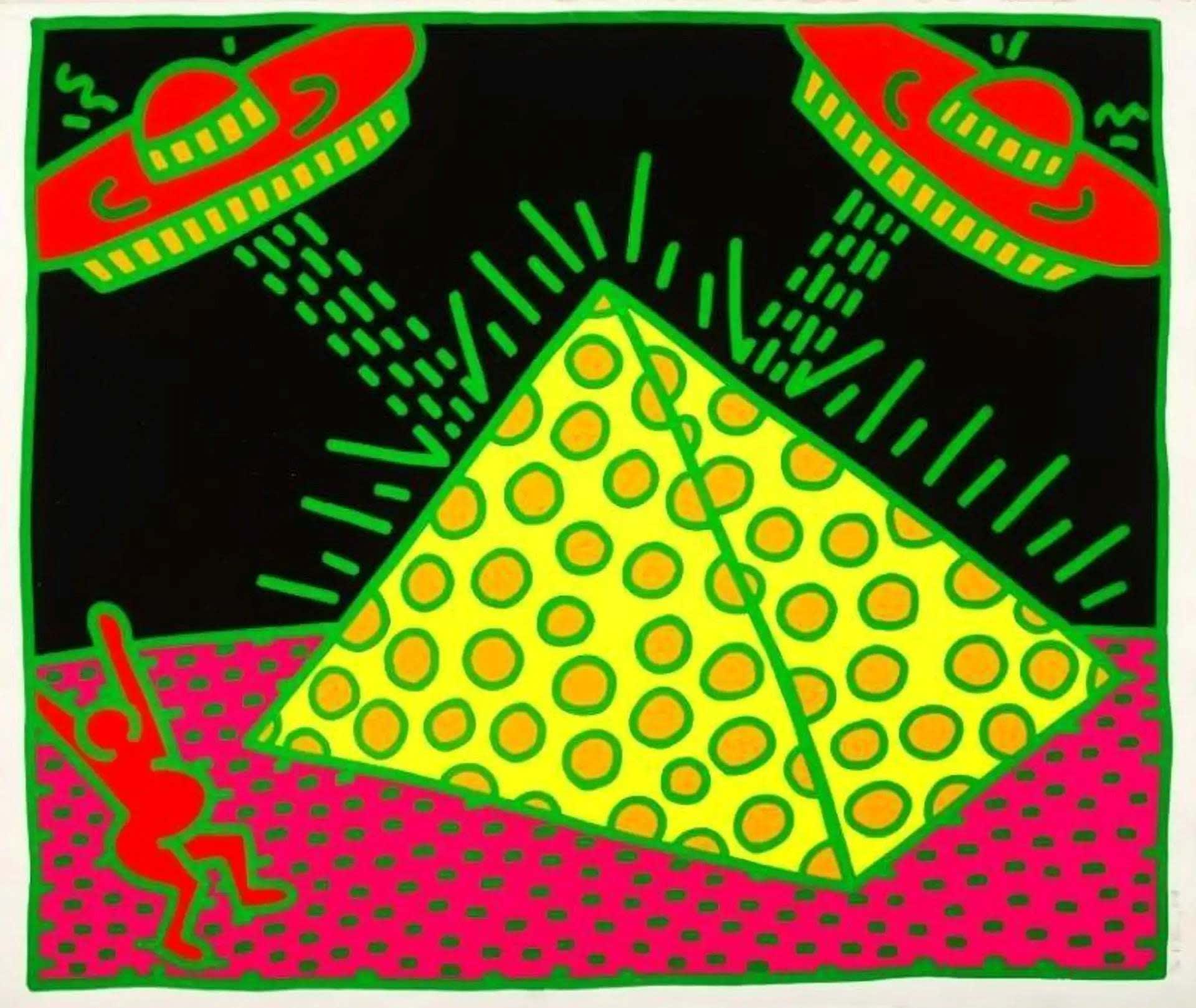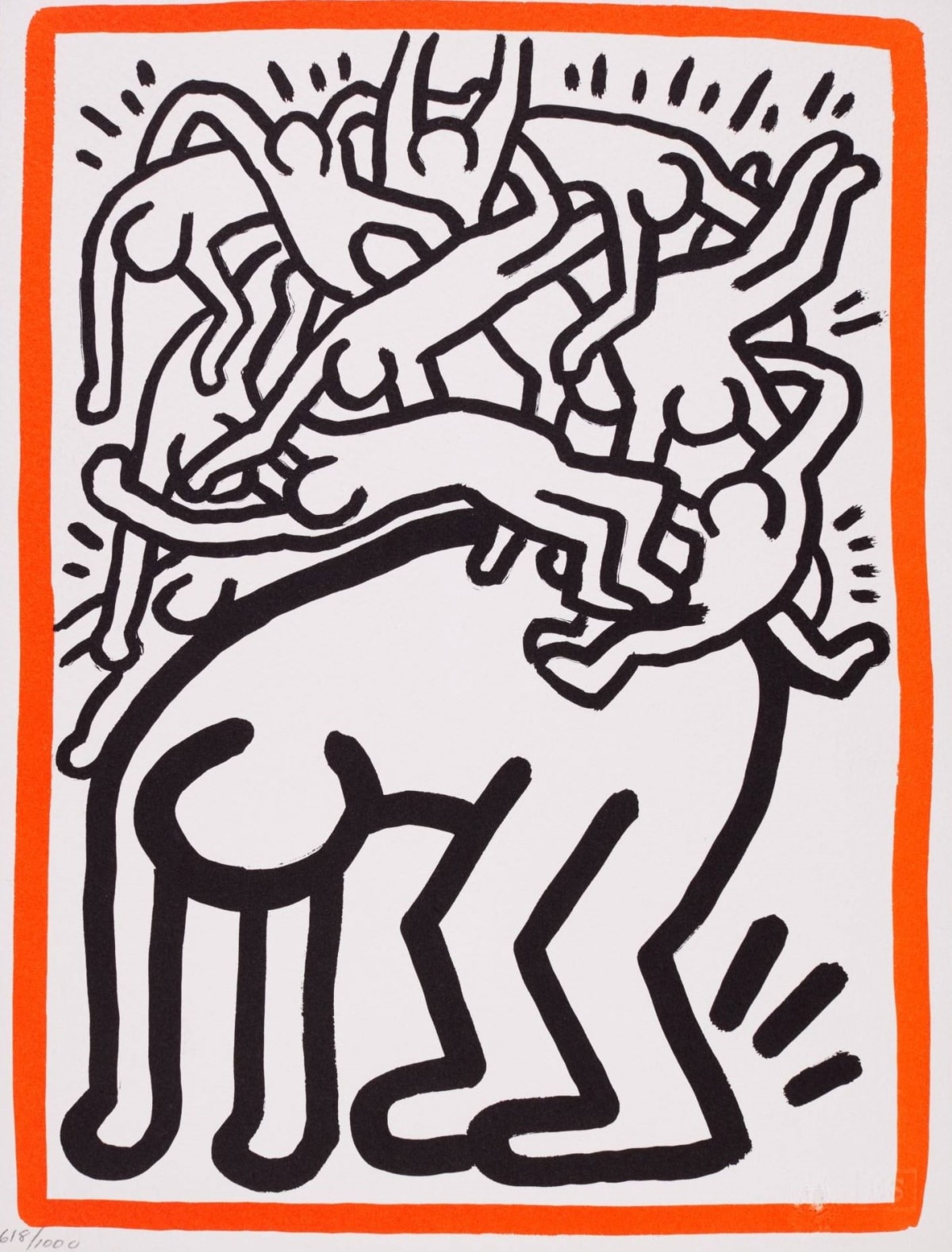

Untitled 1-5 is a collection of five screenprints created by the artist in 1983, collectively known as the Fertility Suite series. This series delves into the HIV epidemic in Sub-Saharan Africa, offering a vivid and expansive perspective on an important yet understated issue. At the time of its creation, HIV/AIDS was shrouded in stigma and received limited attention. Consequently, the Fertility Suite stands as a seminal body of work for Keith Haring, cementing his reputation as a social and political activist.
Within the Fertility Suite, Haring's signature featureless matchstick figures take on a unique form: they all bear prominently protruding pregnant bellies. These figures engage in prayer and dance with a ritualistic fervour. In the first plate, four women extend their arms towards a baby suspended in the sky. This floating baby, often referred to as Haring's 'Radiant Baby,' serves as a signature motif seen throughout his oeuvre. Haring described it as "the purest and most positive form of human existence," symbolising the simplicity and joy of life. However, in this context, even the Radiant Baby is tragically tainted, as green spots covering its form allude to disease and infection, highlighting the risks of HIV transmission during pregnancy.
The second plate introduces another iconic Haring symbol: the UFO. Two extraterrestrial spacecrafts beam down upon a pyramid covered in spots, while a pregnant woman raises her arms in supplication. Haring blends elements of the ancient (the pyramid) and the extraterrestrial (the UFO) to create a narrative open to interpretation. Nonetheless, it conveys the idea that the pregnant woman is seemingly at the mercy of an otherworldly force, seeking guidance and help from above, both literally and metaphorically. The colour palette of black, yellow, and pink contributes to the scene's ominous and foreboding atmosphere.
Plates three to five feature Haring's familiar matchstick figures alongside colossal, god-like figures, open to multiple interpretations as fertility deities or representations of the disease itself. In plate four, two pregnant women with touching palms are embraced by a central figure bearing an ankh-shaped abdomen. This same ankh symbol appears in the final plate, where a towering character is supported by five smaller pregnant figures. The ankh, an ancient Egyptian symbol representing life and its bestowal, adds a layer of meaning, emphasising the power of African women in the face of adversity.
The scenes within the Fertility Suite oscillate between celebration and foreboding. Haring grapples with a cruel disease that claimed many lives, using his neon palette to counteract the darkness of the events. Importantly, he grants Sub-Saharan women a life-affirming narrative and much-needed representation, portraying them as part of a community with a rich history and culture. In his portrayal, they are not defined solely by the disease they suffer from.
Five years after creating the Fertility Suite, Keith Haring was diagnosed with AIDS in 1988. This personal experience fueled his motivation to raise awareness about the illness and combat the stigma surrounding it. While discussions about homosexuality and AIDS are common, the Fertility Suite stands out for its global activism, as Sub-Saharan women continue to be disproportionately affected by AIDS and face significant risks during pregnancy. This series remains relevant and prescient in today's world.

"Fight Aids Worldwide" is a lithograph created by Haring in 1990, reflecting his personal battle with AIDS. At this stage in his career, Haring dedicated his artistic output to raising awareness about the epidemic that had claimed countless lives. Although he had always been an outspoken artist on social and political issues, his activism reached its peak during these years.
The artwork depicts a human mound in which numerous individuals are piled atop a larger figure, crushed under the weight of the bodies. It is a simple yet powerful representation of the multitude of anonymous victims lost to the AIDS epidemic. In 1983, over three thousand people had already succumbed to the virus, yet it wasn't until 1985 that President Reagan publicly addressed the issue. By 1990, AIDS cases had skyrocketed, with over forty thousand reported cases, constituting a quarter of all cases reported over a nine-year period. Haring's growing frustration with the lack of political acknowledgment and support for victims is palpable in this work. Even before his own diagnosis, the artist was deeply affected by the disease, stating that his friends were "dropping like flies." The use of black, white, and red colours, along with the simplicity of the image, condenses the message into its most direct and easily understandable form.

"Silence=Death" is a silkscreen print created by Haring in 1989, explicitly addressing the lack of awareness surrounding AIDS, as emphasised by its striking title. At this stage in his career, having been diagnosed with the virus a year earlier, this image represents the culmination of Haring's practice of using art as a form of social activism.
The vivid contrast between fuchsia and a black background creates a striking visual impact that is well-suited to Haring's serious subject matter. The pink shape reclaims an inverted triangle symbol previously used by the Nazis to label homosexuals in internment camps, transforming it into a symbol of pride.
The iconography of "Silence=Death" is closely tied to the political climate of its time. The densely packed figures traverse the entire image, covering their eyes and ears, serving as a visual metaphor for the willful ignorance and inaction surrounding the epidemic. Mass media coverage often focused on fear-mongering, dehumanising the suffering of individuals and instead emphasising statistics and the incurable nature of the disease. Haring's characteristic faceless and genderless figures effectively represent the anonymous masses. By 1984, AIDS had claimed over three thousand American lives, yet it wasn't until 1985 that President Ronald Reagan publicly addressed the issue. Haring's personal experience with the disease, even before his own diagnosis, deeply influenced his activism, as many of his friends and acquaintances had already been lost to AIDS. He remarked, "My friends are dropping like flies, and I know in my heart that it is only divine intervention that has kept me alive this long... This is why my activities and projects are so important now."
Discover our collection of Keith Haring prints for sale or contact Andipa to buy Keith Haring original art. To speak to a member of our team, contact sales@andipa.com or call +44 (0)20 7589 2371.